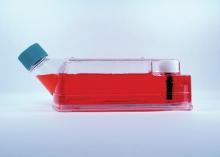Our researchers have developed a novel culture substrate combination that robustly supports human pluripotent stem cell (hPSC) proliferation and pluripotency in chemically defined conditions. hPSCs grown on this novel substrate culture display higher proliferation rates and pluripotency marker expression than current gold-standard culture substrates Geltrex- and vitronectin-coated plastic. Because this invention uses human recombinant proteins in combination with chemically defined media, it addresses the unmet need for defined culture platforms (culture substrate and media) required to generate clinical-grade cells for future cell therapy and broader medical applications. Furthermore, these substrates provide additional benefit to basic research through avoiding lot-to-lot variation and potential confounding effects associated with using undefined matrices (Geltrex and Matrigel).
OPPORTUNITY
Human pluripotent stem cells (hPSCs), including embryonic stem cells (ESCs) and induced pluripotent stem cells (iPSCs), show great promise for regenerative medicine and disease treatment as they have the potential to differentiate into all cell types of the body. Since their initial derivation, considerable progress has been made towards transitioning hPSCs from a laboratory tool into a viable clinical therapy. hPSCs have been differentiated into variety of functional cell types, including insulin-secreting beta cells, dopamine-secreting neurons, and spontaneously contracting cardiomyocytes. These functional cells, among others, showcase the capacity for hPSCs to revolutionize research and treatment of numerous degenerative diseases.
Despite their enormous potential, the translation of hPSC therapies is stagnant: there remains an unmet need for defined culture conditions that will permit massive expansion of hPSCs for downstream tissue engineering, drug discovery, and regenerative medicine applications. Current hPSC culture methods use poorly defined materials and largely rely on animal-derived products. Gold-standard hPSC culture practices involve growing cells on either mouse embryonic fibroblasts (MEF) feeder layers or Matrigel, a mouse sarcoma protein extract, to maintain hPSC pluripotency. These poorly defined, animal-derived culture substrates pose significant safety concerns if cells grown in these conditions are used in the clinic. Thus the Simmons' lab sought to develop chemically-defined culture substrates that could support hPSC pluripotency and proliferation to equal or greater levels than cells grown on Matrigel and MEFs when used in combination with commercially-available culture media.
COMPETITIVE ADVANTAGE
- Does not display cell line variability
- Significant increase in cell line stability
- Maintains the stem cells in their pluripotent state over several weeks
- Much higher proportion of stem cells remain in their pluripotent state
- Not dependent on end-user's experience and technique





